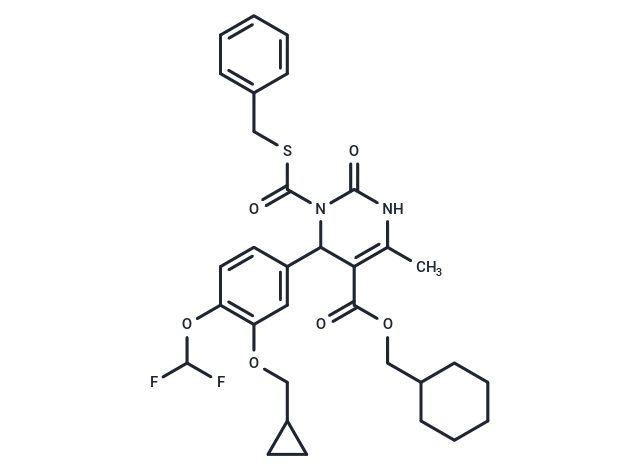Shopping Cart
- Remove All
 Your shopping cart is currently empty
Your shopping cart is currently empty

PDE1-IN-7 (Compound 13h), with an IC50 value of 10 nM, selectively inhibits bPDE1. This compound demonstrates significant anti-fibrotic effects in a BDL-induced liver fibrosis rat model and is useful for research purposes in studying liver fibrosis [1].

| Pack Size | Price | Availability | Quantity |
|---|---|---|---|
| 10 mg | Inquiry | 10-14 weeks | |
| 50 mg | Inquiry | 10-14 weeks |
| Description | PDE1-IN-7 (Compound 13h), with an IC50 value of 10 nM, selectively inhibits bPDE1. This compound demonstrates significant anti-fibrotic effects in a BDL-induced liver fibrosis rat model and is useful for research purposes in studying liver fibrosis [1]. |
| Targets&IC50 | PDEI:10 nM |
| In vitro | PDE1-IN-7 (concentration of 2.5-20μM; incubation time of 48 hours) dose-dependently reduces the expression levels of fibronectin, collagen I, and α-SMA induced by TGF-β in human hepatic stellate cells LX-2, effectively inhibiting the myofibroblast differentiation and proliferation triggered by TGF-β in these cells [1]. The effects of PDE1-IN-7 on LX-2 cells were confirmed via Western Blot Analysis [1], validating its impact. |
| In vivo | Administered intraperitoneally (i.p.) at a dose of 2.5 mg/kg daily for 21 days, PDE1-IN-7 demonstrated significant antifibrotic effects in a rat model of bile duct ligation (BDL)-induced liver fibrosis [1]. Pharmacokinetic analysis following an intravenous (i.v.) injection of 2.5 mg/kg revealed a half-life of 7.51 ± 0.64 hours, a maximum concentration (C max) of 25,006 ± 3082 ng/mL, an area under the curve (AUC ∞) of 6317 ± 839 (h)(ng·/mL), a clearance rate (Cl obs) of 6.56 ± 0.81 mL/min/kg, a mean residence time (MRT) of 1.77 ± 0.07 hours, and a steady-state volume of distribution (V ss_obs) of 698 ± 104 mL/kg. The compound significantly reduced levels of alanine aminotransferase (ALT), aspartate aminotransferase (AST), and total bile acids (TBA), alleviated structural damage in liver tissues, decreased fibrotic lesions and collagen deposition, and markedly reduced the protein expression levels of α-SMA and collagen I, while notably increasing cAMP levels. |
| Molecular Weight | 614.7 |
| Formula | C32H36F2N2O6S |
| Cas No. | 3027833-49-1 |
| Storage | Powder: -20°C for 3 years | In solvent: -80°C for 1 year | Shipping with blue ice. |

Copyright © 2015-2025 TargetMol Chemicals Inc. All Rights Reserved.